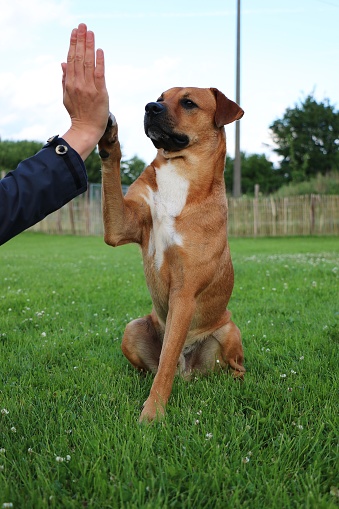Table of Contents
It seems an elementary question, but asking people whether they’re right or left-handed can offer some genuine insight into their world. In fact, researchers have discovered that there are notable physiological and neurological differences between right, left, and ambidextrously-handed people. Given our focus on pets, you probably know where this is going. Does the same “left and right-pawed” data apply to our furry friends? We did some backyard-style digging to find the answer.

The science on dog paws
Dog parents aren’t the only people who are curious about whether pups can be a proper “righty” or “lefty.” Scientists have been equally intrigued by this topic, as well. Via an assortment of tests and studies, they’ve concluded that yes, dogs can have a dominant paw.
How to find your dog’s dominant paw
One such test is referred to as the “Kong Test.” This method determines dog “lateralization” by presenting a food-filled Kong toy and then observing the dog’s behavior over the course of an hour. Scientists compare how many times the left and right paw is used to hold the toy down, as well as whether both paws are used at the same time. Numerous studies have utilized this test when conducting their own related research, with many concluding that dogs have an equal preference for right, left, and both.
The First-Stepping Test is another popular test, which some scientists prefer over the Kong Test since it eliminates the hunger factor. Dogs are observed for a total of 20 minutes while researchers record which foot they step forward with 50 times. The study “revealed more significant paw preferences than the Kong Test” with more dogs presenting as right-pawed.
What your dog’s dominant paw means
As you know, right and left-handedness can give us insight into the way human brains organize thoughts and emotions. Some scientists argue that a dog’s paw preference can potentially do the same.

For example, researchers at Australia’s University of Adelaide conducted a study to determine if there was any correlation between a dog’s dominant paw and its emotional responses. In the study, they used the Kong Test on 73 dogs to first determine whether each was right or left-dominant. In their sample group, they determined that 37% of dogs had no preference, 34% were left-pawed, and 29% were right-pawed.
From there, they studied emotional patterns via the Canine Behavioral Assessment and Research Questionnaire (C-BARQ). This is a popular and accepted questionnaire in the science community that assesses canine behavior through expressions of aggressiveness, fearfulness, sociability, excitability, and response to training.
“While the data did not show major differences between left and right-pawed dogs across a broad spectrum of emotional behaviors, some interesting results emerged when it comes to aggressive responses that dogs are apt to make toward unfamiliar people. Here it seems that the left-pawed dogs were more likely to show such aggression,” states Dr. Stanley Coren for Psychology Today.
Dr. Luke Schneider, who lead the study, said he found “a statistically significant relationship between stranger-directed aggression and the presence of a paw preference” and that “dogs without a paw preference demonstrated lower aggression scores.”
Interestingly, this conclusion is consistent with what researchers see in left-handed humans, who have a higher tendency to react with negative emotions and aggressive behavior compared to those who are right-handed.
Final takeaway
It’s important to acknowledge that many other factors can affect a dog’s personality aside from its paw dominance. This is not limited to breed, any experienced trauma, age, and even sex. It’s also worth noting that this is just one study, and there’s still much room for additional research. The primary takeaway from what we’ve learned so far, though, is that many dogs do, indeed, have a dominant paw, and that this can potentially provide us insight into their behavior in the same way it can for humans.
Holy studies, batman! Raise your right or left hand if you found all that science-y stuff as fascinating as we did — and feel free to share your thoughts with us at @gohealthypaws on Twitter. BTW, if you aren’t already a pet parent with us, look into getting a free quote to help safeguard your furry friend and wallet.






